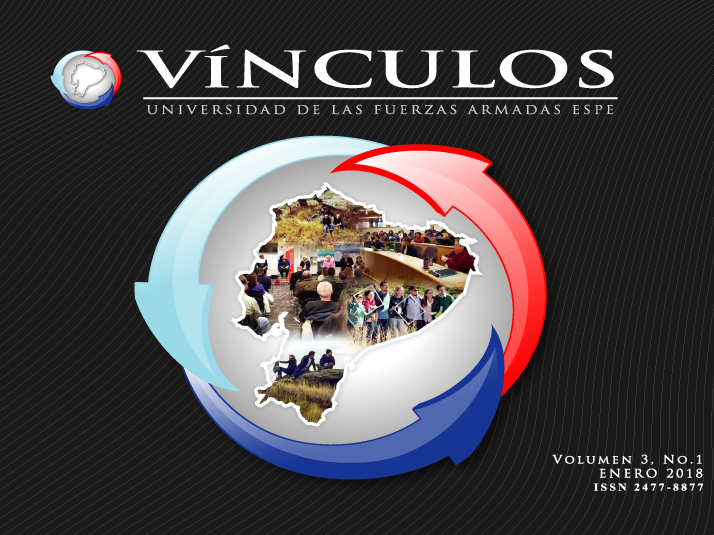

Global complex issues such as gender equity, sustainable cities, access to clean water, and good governance are addressed at the 2030 Agenda and its 17 Sustainable Development Goals adopted by the United Nations in 2015. The achievement of those calls for new ways of structuring knowledge that transcend disciplinary, institutional and geographical boundaries.
In particular, global change issues are positioned at the intersection of science, policy, and practice. Effective resolution requires the synergy of different actors including citizens, industry, policy makers and scientist from different disciplines. This in turn, requires research paradigms to evolve towards more inclusive, crossdisciplinary and problem-oriented research, aimed at producing knowledge and policy-relevant solutions, an approach termed “transdisciplinary research”.
The current special issue of Vinculos-ESPE, “Transdisciplinary Approaches to Integrating Policy and Science for Sustainability” is timely in its direct response to the challenges mentioned above. Collectively, the studies presented exemplify the efforts among scholars and professionals that address the dimensions of transdisciplinary research: cross-disciplinary breadth, geographic scale, interorganizational collaborations and multi-sectoral teams. The letter to the editor presents a professional development initiative organized by the Inter-American Institute for Global Change Research (IAI) whose relevant contributions are included in this issue. First, press release articles are presented acknowledging science communication as an integral part of transdisciplinary science practice; next, technical notes present reflections on advantages and limitations of transdisciplinary research in practice and how to engage stakeholders. Finally, results of a research project on priorities to build sustainability sciences and education are presented.
On behalf of the editorial team, I would like to thank the scientific committee for their engagement, ideas and knowledge, critical to the development of this special issue. Furthermore, we congratulate the authors for their valuable contributions. We hope this issue will engage readers to nurture discussions advancing transdisciplinary research, enhancing its visibility while recognizing and strengthening its effectiveness.
Problemas globales tales como equidad de género, ciudades sostenibles, acceso al agua potable, buena gobernanza, entre otros, se reconocen en la Agenda 2030 y sus 17 Objetivos de Desarrollo Sostenible adoptadas por las Naciones Unidas en 2015. El logro de los mismos exige nuevas formas de estructurar el conocimiento que trascienda los límites disciplinarios, institucionales y geográficos.
En particular, los problemas referentes al cambio global se ubican en la intersección de la ciencia, política y práctica. Una resolución efectiva requiere de la sinergia de diferentes actores, incluidos ciudadanos, industria, hacedores de política pública y científicos de diferentes disciplinas. Esto exhorta a que los paradigmas de investigación evolucionen hacia una práctica más inclusiva, interdisciplinaria y orientada a los problemas, dirigida a producir conocimiento y soluciones relevantes para las políticas, un enfoque denominado “investigación transdisciplinaria”.
El presente número especial de Vinculos-ESPE, “Enfoques transdisciplinarios para la integración de políticas y ciencia para la sostenibilidad” es oportuno, constituye una respuesta directa a los desafíos mencionados anteriormente. Los artículos presentados ejemplifican los esfuerzos entre académicos y profesionales que abordan las dimensiones de la investigación transdisciplinaria: amplitud interdisciplinaria, escala geográfica, colaboraciones inter-organizacionales y equipos multisectoriales. La carta al editor presenta una iniciativa de desarrollo profesional organizado por el Instituto Interamericano para la Investigación del Cambio Global (IAI). La sección comunicados de prensa, reconoce la comunicación de la ciencia como parte integral de la práctica transdisciplinaria; seguido de notas técnicas, las cuales presentan reflexiones sobre las ventajas y limitaciones de la investigación transdisciplinaria y cómo involucrar a las comunidades beneficiarias. Finalmente, se presentan resultados de una investigación sobre prioridades para construir ciencias y educación en sostenibilidad.
En nombre del equipo editorial, me gustaría agradecer al comité científico por su fundamental participación en el desarrollo de este número especial. Esperamos que este tema atraiga a los lectores y los motive a nutrir discusiones que promuevan la investigación transdisciplinaria.
Jessica Duchicela
Universidad de las Fuerzas Armadas ESPE
Editor
Almost 26 years ago, 12 nations from across the Americas recognized that the longterm chemical, biological and physical processes and cycles of the Earth system were undergoing continuous alterations that were both natural in origin and human-induced, in what is known as global change. They also expressed their concern that global change might affect the resources vital to human wellbeing and that of other species, and that our scientific knowledge on global change was incomplete. Moreover, these nations believed that policymakers were in need of accurate information characterizing the impacts of global change, and that to tackle these great challenges, we needed enhanced cooperation among institutions and countries of the Americas. These concepts became the foundation of the Inter-American Institute for Global Change Research (IAI), an intergovernmental organization with 19 current Parties that promotes scientific research and capacity building to inform decision-making on the American continents.
To better understand global change and its impacts, and more importantly, to effectively communicate scientific results to support policy and decision making to serve society, we need to integrate expertise from different scientific disciplines and other types of knowledge. Nevertheless, integrating different types of knowledge is not easy and requires cutting-edge approaches and innovative programs that bring a diversity of experts and professionals together to address common problems.
An initiative to promote integration and collaboration among disciplines, communities, sectors and nations, was the IAI’s Professional Development Seminar on Transdisciplinary approaches to integrating policy and science for sustainability held in the Dominican Republic in 2016 and Canada in 2017. Almost 40 professionals, from 15 IAI Parties, participated in this seminar. The group was composed of professionals from government, the private sector, research institutes, NGOs, indigenous communities and academia. The diversity of professionals was key to engaging in the identification of common global change problems across faculties and borders ¬– and to seek research and policy-based solutions. This engagement was fundamental to the development of collaborative research projects and to the overall achievements of the IAI event.
Four transdisciplinary projects emerged during the Professional Development Seminar. They address important socio-economic
environmental themes: water governance; improving the livelihoods and resilience of cocoa producers; and native grassland sustainability for biodiversity conservation and livelihood security. These projects are great examples of how activities such as the IAI Transdisciplinary Approaches seminar can contribute to establishing research networks composed of scientists from different disciplines working together with policy and decision makers. Two of these projects are in the process of receiving financial support from the private sector to support the development of their research.
We hope that the scientific collaborations and science-policy networks established at the IAI seminar are long-lasting and that other professionals and institutions engage in and support transdisciplinary approaches to integrating disciplines, knowledge types, communities, sectors and nations. There is no single recipe for transdisciplinary research, but goodwill, openness, respect, dialogue, and communication are important elements for a good start.
Marcella Ohira
Deputy Executive Director and Director for Capacity Building
Inter-American Institute for Global Change Research (IAI)
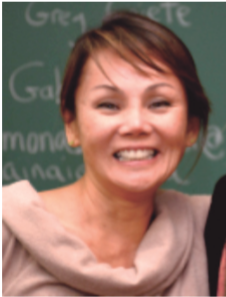 Marcella Ohira is Deputy Executive Director and Director
for Capacity Building at the Inter-American Institute for Global
Change Research (IAI). She has organized more than 25 IAI
training events, including interdisciplinary training institutes,
professional development seminars and science for policy
fora on several global environmental change issues. She
has also worked in international technical cooperation at the
Brazilian Cooperation Agency and the Division of Technical
and Technological Cooperation of Brazil’s Ministry of Foreign
Affairs. In addition, Marcella has worked at the U.S. NOAA
´s Office of Global Programs (OGP) in support of regional
global change organizations. Marcella has a Masters of Arts in
International Relations - International Economics and Science,
Technology and the Environment from the Johns Hopkins University/The Paul H. Nitze
School of Advanced International Studies (SAIS), Washington, DC, USA and Bologna, Italy,
and a Bachelor of Arts in International Relations from the University of Brasília, Brasília,
Brazil.
Marcella Ohira is Deputy Executive Director and Director
for Capacity Building at the Inter-American Institute for Global
Change Research (IAI). She has organized more than 25 IAI
training events, including interdisciplinary training institutes,
professional development seminars and science for policy
fora on several global environmental change issues. She
has also worked in international technical cooperation at the
Brazilian Cooperation Agency and the Division of Technical
and Technological Cooperation of Brazil’s Ministry of Foreign
Affairs. In addition, Marcella has worked at the U.S. NOAA
´s Office of Global Programs (OGP) in support of regional
global change organizations. Marcella has a Masters of Arts in
International Relations - International Economics and Science,
Technology and the Environment from the Johns Hopkins University/The Paul H. Nitze
School of Advanced International Studies (SAIS), Washington, DC, USA and Bologna, Italy,
and a Bachelor of Arts in International Relations from the University of Brasília, Brasília,
Brazil.
1IAI Parties are Argentina, Bolivia, Brazil, Canada, Chile, Colombia, Costa Rica, Cuba, Dominican Republic, Ecuador, Guatemala, Jamaica, Mexico, Panama, Paraguay, Peru, United States of America, Uruguay and Venezuela.
MARIANA TOLEDO
Inter-American Institute for Global Change Research, AV. Italia 6201 - Ed. Los Tilos 102 - 11500 Montevideo - Uruguay
marianatoledo@dir.iai.int
The Inter-American Institute for Global Change Research (IAI) organized the Professional Development Seminar (PDS) to Transdisciplinary approaches to integrating policy and science for sustainability. Funded by the National Science Foundation (NSF) and co-funded by the American Association for the Advancement of Science (AAAS), Sao Paulo Research Foundation (FAPESP) and the Michigan Technological University, the event was divided in two sessions, the first was held from November 28th to December 2nd, 2016 in Puerto Plata, Dominican Republic, and the second was held from October 3rd to 7th, 2017 in Calgary and Banff, Canada.
The main objective was to train future leaders in science, policy, and global change management, offering practical training on skills to encourage teamwork and interactions between scientists, society and decision makers. The initiative came from the complexity of climate change phenomena, its problems and impacts on society in socioeconomic, biophysical and technological dimensions, and the needs for effective communication and collaboration between scientists and those who are affected by sustainability policy.
“I feel far more equipped with the knowledge, skills, and attitudes needed to be successful in interdisciplinary and transdisciplinary research.” Caitlin Quarrington - MindFuel (Science Alberta Foundation), Canada
The Seminar had 27 participants from 15 countries in the Americas: Argentina, Bolivia, Brazil, Canada, Chile, Colombia, Cuba, Ecuador, Guatemala, Jamaica, Mexico, Peru, Dominican Republic, Uruguay and USA. The group was composed by professionals from private sectors, government, research institute, NGOs, indigenous community and academia. The diversity of the group contributed to the success of the event.
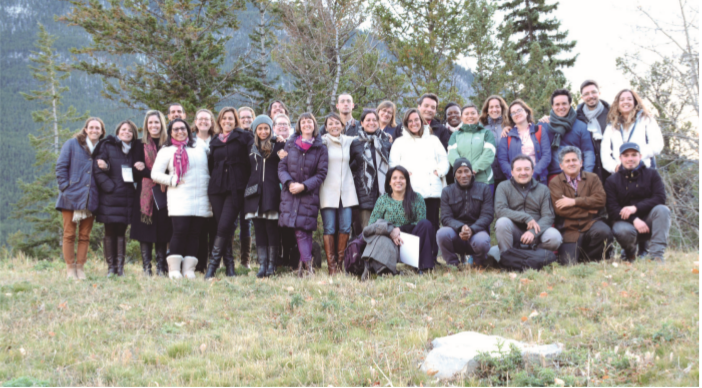
Seminar group – Banff, Canada - Photo by Igor Jakab.
“Since I’m already in the role of policy maker, the Seminar brought me tools to acknowledge and engage other stakeholders in the process and try to enlarge the participatory level as much as possible.” Gabriel Lui - Ministry of the Environment, Brazil
In both sessions, participants attended several presentations throughout the week, participated in hands on exercises and group discussions on themes related to the Seminar. The Dominican Republic’s field trips were divided in two different places with examples of sustainability: an ecological dairy farm in Las Caobas, that presented its history, area, milk production and derivatives. The other one was the organic cocoa plantation in Altamira, where everyone could hear about the work done and the importance for the environment. In Canada, the field trip was focused on making connections, they visited two sacred places for the indigenous community in Canada: Sundial Hill Medicine Wheel (goo. gl/dhD5GD) and Women’s Buffalo Jump (goo.gl/VCp5if). The group was led by Ramona Big Head of the Blackfoot Nation community and director of Kanai High School and Dwayne Donald, Cree First Nation, University of Alberta. They were able to share not only beautiful places, but part of their history and culture, the life of the native Canadians and the importance of these places to ensure the perpetuation of its history and identity.
“In Puerto Plata, we focused on integrating disciplines, how to do and to learn the best practices, and in Banff it was more about connecting people, how to engage people, and how the communication is important for that. It is important people to understand each other, to know their limitations and potentialities, and how it brings strength to the relationship and to conduct a transdisciplinary work. The result will be much better, people connected for a common purpose.” Tatiana de Souza - Conservation International (CI-Brazil), Brazil
As part of the program, the participants had group activities that were designed to develop proposal writing skills, encourage networking, and promote the application of training provided to urgent, realworld problems that have a significant global change dimension. Four collaborative groups were established and they have worked on a research project proposal. The projects will start in 2018.
More information about the IAI and the Seminar you can find at the website: http://www.iai.int/?p=24364
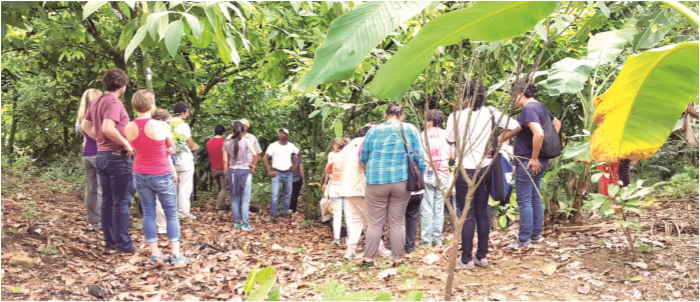
PABLO MODERNEL
Universidad de la República, Av. 18 de Julio 1824-1850, 11200, Montevideo - Uruguay
pablomodernel@gmail.com
The Grasslands Research Team (GRT), a collaborative group comprised of eight specialists from six different countries, convened in Calgary and Banff, Alberta in October 2017 to release a proposal focusing on “the forgotten ecosystem” of native grasslands in the Americas. This work highlights the critical nature of grasslands and proposes a two-year timeline to unite scientists, government, NGOs and farmers in protecting this vulnerable ecosystem.
Although grasslands are frequently ignored in the conservation dialogue in favor of other ecosystems such as rainforests or the Arctic, the research team argues that grasslands should be at the forefront of environmental conservation agendas. Covering 23 percent of the world’s land surface, only five percent of grasslands around the world are protected. The main economic activity on this ecosystem is grazing livestock, which has been posed as a threat for the environment. But this seems to be only one side of the story. This relation between conservation and production is a topic to be explored. “Addressing the various factors - social and ecological - that impact grasslands conservation and farmers’ livelihoods is critical to the future of the ecosystem and the Earth”, said Pablo Modernel, principal investigator of the project.
The team plans to create a framework that illustrates the interactions of these various factors, identify ways that farmers on grasslands can support sustainable land use and conservation, and then make recommendations for policy in specific countries with significant temperate grasslands in North and South America (Canada, Argentina, Brazil and Uruguay). This holistic approach will address the complexity posed by the social and ecological factors informing the framework.
Representing the Inter-American Institute for Global Change Research
(IAI), the GRT is eager to communicate the importance of grasslands
conservation beyond just the scientific community, recognizing the need
for collaboration to face this global challenge. The team has received a
commitment of funding from the IAI to kick off research and looks forward to
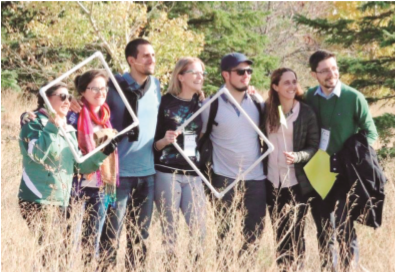 connect with other
stakeholders
in the coming
months in the
hopes of obtaining
additional funding
for farmer surveys
and external
engagement in this
work. For more
information, visit
http://www.iai.
int/?p=24364.
connect with other
stakeholders
in the coming
months in the
hopes of obtaining
additional funding
for farmer surveys
and external
engagement in this
work. For more
information, visit
http://www.iai.
int/?p=24364.
Caitlin Quarrington, MindFuel (Science Alberta Foundation), Canada
Bastián Oñate, Corporación Alerce, Chile
Gabriel Lui, Ministry of Environment, Brazil
Jeremy Pittman, University of Waterloo, Canada
Jessica Duchicela, Universidad de las FF.AA., Ecuador
María Virginia Vilariño, CEADS, Argentina
Natalia Zaldúa, Vida Silvestre, Uruguay
ALEXANDER RINCON RUIZ RINCON
National University of Colombia, School of Economics, Cra 30 No 45 03, Building 311 –Office 4B, Bogotá D.C. - Colombia
alrinconru@unal.edu.co
A multinational project to identify key aspects of the decision-making structure for water management that affect water provision in Latin American will be conducted by a diverse group of researchers, NGO practitioners and local communities to inform policy makers in Brazil, Chile, Argentina and Colombia. The main researchers are Alexander Rincon, PhD. of National University of Colombia (Colombia), Maíra Padgurschi, PhD. of State University of Campinas (Brazil), Jorge Vergara, PhD. of the Foundation Desierto de Atacama (Chile), Tatiana Souza, Msc. of the NGO Conservation International and Erica Carrizo, Msc. of the Ministry of Science, Technology and Productive Innovation (Argentina). In the next two years, the group will produce local assessments through an approach that integrates social and natural sciences and knowledge from distinct social actors. The major result of the project will be an informative document for policy makers to support decision making with scientifically credible, legitimate and relevant information. The group is formed by economists, agronomists, biologists, anthropologists and local leaders who have experience conducting projects of this scope in the four countries of study.
Access to water is an important human right and essential to achieve the United Nations Sustainable Development Goals, the global sustainability agenda to be achieved by 2030. According to the last United Nations World Water Development Report (2015), the priority for Latin America is to build the formal institutional capacity to manage water resources and bring sustainable integration of water use into socio-economic development. Therefore, the identification of the links between the water provision and the aspects that influence its management is an essential need for policy makers of Latin America countries. The purpose of the project is to gather all the
knowledge available, from scientific to empirical, from formal institutions to local communities, and integrate it into a holistic framework.
To conduct this integrated approach, the research group will use the Intergovernmental Science-Policy Platform on Biodiversity and Ecosystem Services (IPBES) concepts and framework. The IPBES is an intergovernmental body which assesses the state of biodiversity and of the ecosystem services it provides to society, in response to requests from decision makers. The project will be innovative by applying for the first time the conceptual framework of IPBES at the local level, including different countries, different ecosystems, an interdisciplinary team and, most importantly, a common idea “water governance in Latin America”.
“We expect our project to be the starting point of a longer research project in the region focused in water provision. In this framework we envision the creation of a strong network of committed researchers, NGO’s and community representatives with the skills to successfully recognize, analyze and help solve pressing global environmental challenges through an approach that integrates different viewpoints in our home countries and internationally” said Alexander Rincón, principal researcher of the project.
Maíra C. G. Padgurschi, Plant Biology Department, Biology Institute, State
University of Campinas, UNICAMP, Brazil
Jorge Vergara Castro, Foundation Desierto de Atacama, Chile
Tatiana Souza, Conservation International, Brazil
Erica Carrizo, Ministry of Science, Technology and Productive Innovation,
National University of San Martín – UNSAM, Argentina
ERIN C. PISCHKEa, LUCÍA PÉREZ VOLKOWb, MAYRA FRAGOSO-MEDINAb, LAURA AGUIRRE FRANCOb
a Postdoctoral researcher, Environmental and Energy Policy, Michigan Technological University, 1400 Townsend Drive, 209 Academic Office
Building, Houghton, MI 49931 USA, epischke@mtu.edu
b Master’s students, Biological Sciences, National Autonomous University of Mexico (UNAM), University City, Mexico City, CDMX, Mexico
ABSTRACT:
In November 2016, a group of students from the Americas participated
in an Inter-American Institute for Global Change Researchfunded
two-week course organized by professors from the National
Autonomous University of Mexico. The aim was to teach students and
young researchers how to collaborate with non-scientists to conduct
socioecological systems research in a transdisciplinary manner. This
article will review the benefits as well as the challenges to doing so.
It concludes with recommendations that other research teams can
follow when conducting similar research that crosses disciplinary and
international borders.
KEYWORDS:
Transdisciplinarity; Latin America; Mexico; water conservation;
socioecological systems
RESUMEN:
En noviembre 2016, un grupo de estudiantes de las Américas participó
en un curso de dos semanas financiado por el Instituto Interamericano
para la Investigación del Cambio Global y organizado por profesores de
la Universidad Nacional Autónoma de México. El objetivo era enseñar
a los estudiantes y jóvenes investigadores cómo colaborar con nocientíficos
para llevar a cabo investigación de sistemas socioecológicos
de forma transdisciplinaria. El presente artículo revisará los beneficios
y los desafíos para hacerlo. Concluye con recomendaciones que otros
equipos de investigación pueden seguir al realizar investigación similar
que cruza fronteras disciplinarias y geográficas.
PALABRAS CLAVE:
Transdisciplinaridad, América Latina, México, conservación de agua,
sistemas sociecológicos.
Recent trends suggest that conducting transdisciplinary researchin which academics from different disciplines and non-academics collaborate on a problem-centered research project (Jahn et al., 2012)—has several benefits. These benefits include the ability to approach problems using multiple methods and analytical frameworks (Kirk-Lawlor & Allred, 2017), the integration of diverse and local perspectives (Hirsch Hadorn et al., 2006), the capacity to view problems from both the bottom up and top down and the integration of non-academic partners (Wickson et al., 2006). Transdisciplinary approaches often lead to robust project outcomes and direct, contextspecific solutions to challenging socio-environmental issues (Schmidt & Pröpper, 2017). For these reasons and more, organizations such as the Inter-American Institute for Global Change Research-IAI (http:// www.iai.int/) fund researchers and practitioners who are devoted to the use and promotion of transdisciplinary research. Despite these benefits, actually conducting transdisciplinary research is challenging. Working in large, diverse teams—especially those that engage with nonacademics— can be more time-consuming and frustrating, particularly when compared to conventional discipline-based projects and courses (Schmidt & Pröpper, 2017). Universities and funding agencies can also be hesitant to support these projects and courses due to their relative nascence (De Torres, 2013; Dieguez et al., 2015). It is critical, then, for scholars to share experiences so we can collectively work towards improved processes and outcomes (Jahn et al., 2012).
In this spirit we seek to share the challenges and benefits from our experience as master’s and doctoral students participating in a twoweek transdisciplinary short course on conceptualizing the management of socio-ecological water systems in Michoacán, Mexico. The course was funded by the IAI, designed and taught by Patricia Balvanera, Tuyeni Heita Mwampamba, Manuel Maas and Elena Lazos Chavero of The Institute for Ecosystems and Sustainability Research (IIES) at the National Autonomous University of Mexico (UNAM) and
Tamara Ortiz Ávila from the community where fieldwork for the course was conducted. The course was carried out on the UNAM campus in the city of Morelia and fieldwork was conducted in Erongarícuaro (hereafter Eronga) in November 2016.
The course involved 17 biological science, agroecology, civil engineering, economics and policy science students from across the Americas and five faculty working with five enthusiastic Eronga community members in charge of forming a Municipal Council for Sustainable Development citizen organization. The emerging nongovernmental organization (NGO) had identified problems managing the municipal water system and were eager to come up with solutions. The course provided an excellent opportunity to work with a rural Mexican town and to learn about water management challenges. The students were tasked with answering: What are the risk perceptions surrounding the hydro-social cycle of the María Valdez spring (main potable water source of Eronga), as well as the vulnerabilities and threats surrounding its use? A critical course outcome was for students to understand the value of conducting transdisciplinary research as well as produce solutions for the emerging citizen organization.
Putting aside the brief timeframe, we came up against several design and implementation challenges that are worth sharing. First, it was important to the professors that course participants develop and maintain an interest in multiple scientific disciplines. There were four course modules (socioecological systems; managing actors and their actions; vulnerability, poverty and governance; and inter- and transdisciplinary research tools) which the students were exposed to. Each of these covered disciplinary perspectives within the topic and the ways in which the disciplines interact and are intertwined. Professors discussed the same topics in the field and led students in exercises designed to facilitate hands-on learning about other
disciplines’ methods and collaboration among diverse groups of students. Despite this, interest was difficult to sustain over two weeks. The majority of the 17 students were from the natural sciences and many were reluctant to break from the methods in which they were familiar. Moreover, citizens who were formerly or currently affiliated with academia comprised the citizen organization’s membership. These factors—students unwilling to wholeheartedly collaborate across disciplines and a lack of engagement with the broader public—made it difficult to create a truly transdisciplinary research design for the class project. Having a more balanced number of students from various disciplines may have encouraged students to entertain and use a wider array of methods, while engagement with several different local NGOs and community organizations could have increased the diversity of perspectives involved in the project.
An additional challenge was around engagement with diverse perspectives. Students were encouraged to interact with community members during the course, but despite collaborating with a community organization to outline goals and gain access to the community, outreach in Eronga and true collaboration was limited to a few staff of the citizen organization. Therefore, community members who were experiencing water management issues were not wholly invested in our research because the request for help from UNAM had come from a small group of people from the citizen organization.
Finally, Eronga has an indigenous Purépecha population that has its own unique practices, symbolic values and environmental beliefs that were unfamiliar to the students and faculty. Most of the citizen organization staff were non-Purépecha, which further highlighted a disconnection between the small organization’s interests and those of the indigenous community members.
While we had many challenges in reconciling indigenous vs. local nonindigenous vs. academic interests on the ground while working Eronga, it was a stimulating and worthwhile experience. Students learned from people in disciplines other than their own and got hands-on experience while working with the citizen organization. As a group, we collaborated with a diverse group of people to approach a problem and collectively design a research strategy that went beyond a purely academic exercise. Applying theoretical concepts in Eronga allowed students to learn (via trial and error) how to conduct transdisciplinary research by seeing a problem from a community organization’s perspective and working with them to begin to solve it.
The successes and challenges of such a course provide opportunities to make recommendations for others who wish to conduct transdisciplinary research and teaching projects. Although there are no silver bullets, we feel similar endeavors should pay close attention to:
• The facilitation of knowledge-sharing between disciplines in the classroom as well as in the field. In our case, students only realized the utility of the course design after having to listen to themed lectures, reflect on them, write about them in assignments and then meditate on them in the field. The application of the material in the field helped the students to make concrete connections between theory and practice.
• Consensus among all groups involved (students, professors, community members) during the research design phase, particularly regarding communication skills. Collaborators should seek to present group work to all involved audiences to build a coherent body of collective knowledge. A project can sustain continuity better if everyone can anticipate what to expect as the project moves along.
• The amount of time actually needed for data collection and analysis. Conducting transdisciplinary research is often more time-consuming than other types of research. Faculty, students and citizen organization staff members worked daily to design our methodology, meet with community members and collect data. After students dispersed once the course ended, it became more difficult to interact with community members from Eronga and find common meeting times when small groups could work on writing the final report to present to the citizen organization.
Several months after the course ended, students delivered a 98-page report to the professors and citizen organization which outlined their findings about the perceived threats to the María Valdez spring’s hydrosocial cycle. The report covers the social organization of Eronga and surrounding communities, management of the environment, including a focus on water management, as well as a review of the cultural makeup of the study location. It offers recommendations to the community and citizen organization for how to bolster integrated management of the local hydro-social cycle. In addition to the written report, a small group of students and one professor returned to Eronga to present findings to the general public and field questions. Some students and professors continue to collaborate while others have kept in touch with the citizen organization.
In conclusion, international problems like climate change have no one cause and no single solution. Solutions must come from many angles, sources and perspectives. Our experience with an academic course that joined engineering, natural and social sciences with a citizen organization to transdisciplinarily study the hydro-social cycle in a rural Mexican community is one example of such an approach to a local community problem. Successful interdisciplinary and transdisciplinary teamwork is, however, in and of itself also a wicked problem (Norris et al., 2016). Identifying and understanding the challenges that transdisciplinary research teams face when conducting research abroad can suggest ways to overcome such barriers. A multi-pronged approach tackles problems from various angles to, in a sense, make the problem smaller and inform future research.
REFERENCES
De Torres, M.F. (2013). Clima en Colectivo/Reflexiones Sobre la
Interdisciplina. In: Picasso, V., Cruz, G., Astigarraga, L., Terra, R. (eds),
Cambio y Variabilidad Climática: Respuestas Interdisciplinarias. Espacio
Interdisciplinario, Universidad de la Republica: Montevideo, 132pp.
Dieguez, F., Toranza, C., Caorsi, M.L., García Cartagena, M. (2015).
Construyendo Interdisciplina en Torno al Cambio y la Variabilidad
Climática. In: Astigarraga, L, Terra, R, Cruz, G, Picasso, V. (eds.), Centro
Interdisciplinario de Respuesta al Cambio y Variabilidad Climática:
Vínculos Ciencia-Política y Ciencia-Sociedad. Espacio Interdisciplinario,
Universidad de la Republica: Montevideo, 142pp.
Hirsch Hadorn, G., Bradley, D., Pohl, C., Rist, S. & Wiesmann, U. (2006)
Implications of transdisciplinarity for sustainability research. Ecol. Econ.,
60, 119-128.
Jahn, T., Bergmann, M. and Keil, F. (2012) Transdisciplinarity: Between
Mainstreaming and Marginalization. Ecological Economics, 79, 1-10.
Kirk-Lawlor, N. and Allred, S. (2017). Group Development and Integration
in a Cross-Disciplinary and Intercultural Research Team. Environmental
management, 59(4), 665-683.
Norris, P., O’Rourke, M., Mayer, A., and Halvorsen, K.E. (2016). Doubling
Down: Transdisciplinary Research Team Formation as a Wicked Problem.
Landscape and Urban Planning, 154, 115-122.
Schmidt, L. and Pröpper, M. (2017). Transdisciplinarity as a Real-World
Challenge: A Case Study on a North–South Collaboration. Sustainability
Science, 12(3), 365-379.
Wickson, F., Carew, A. L., & Russell, A. W. (2006). Transdisciplinary research:
characteristics, quandaries and quality. Futures, 38(9), 1046-1059.
AUTHOR BIOGRAPHIES:
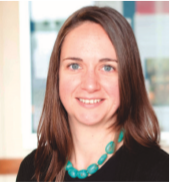 Erin C. Pischke is a post-doctoral researcher in the
Environmental and Energy Policy program at Michigan
Technological University. She conducts energy-related
research in Mexico and collaborates with others on large
international Inter-American Institute for Global Change
Research projects.
Erin C. Pischke is a post-doctoral researcher in the
Environmental and Energy Policy program at Michigan
Technological University. She conducts energy-related
research in Mexico and collaborates with others on large
international Inter-American Institute for Global Change
Research projects.
 Lucía Pérez Volkow is a biology student from the
National Autonomous University of Mexico (UNAM). Her
research focuses on studying traditional management of
charcoal in Mexican oak forests from a socioecological
perspective.
Lucía Pérez Volkow is a biology student from the
National Autonomous University of Mexico (UNAM). Her
research focuses on studying traditional management of
charcoal in Mexican oak forests from a socioecological
perspective.
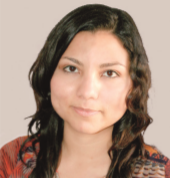 Mayra Fragoso-Medina is a master’s student in
biological sciences at UNAM and Sevilla University
(US) in Spain. Her research focuses on ecology and
restoration of fields invaded by Pteridium sp. in the
Lacandon tropical forest.
Mayra Fragoso-Medina is a master’s student in
biological sciences at UNAM and Sevilla University
(US) in Spain. Her research focuses on ecology and
restoration of fields invaded by Pteridium sp. in the
Lacandon tropical forest.
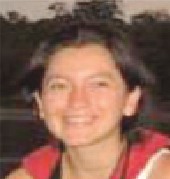 Laura Aguirre Franco is a biologist for the National
University of Colombia and master’s student in biological
sciences at UNAM. Her research focuses on the ecology,
management and restoration of tropical wetlands. She
is interested in using inter- and transdisciplinarity as
conceptual and methodological frameworks in her work.
Laura Aguirre Franco is a biologist for the National
University of Colombia and master’s student in biological
sciences at UNAM. Her research focuses on the ecology,
management and restoration of tropical wetlands. She
is interested in using inter- and transdisciplinarity as
conceptual and methodological frameworks in her work.
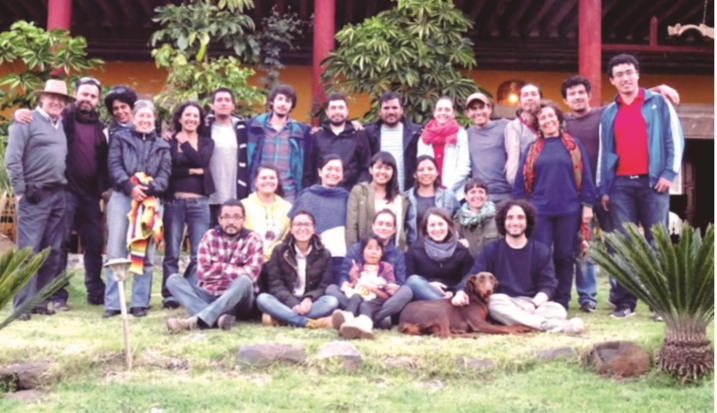
Students, faculty and community members in Erongarícuaro, Mexico (Credit: Dr. Manuel Maass, UNAM)
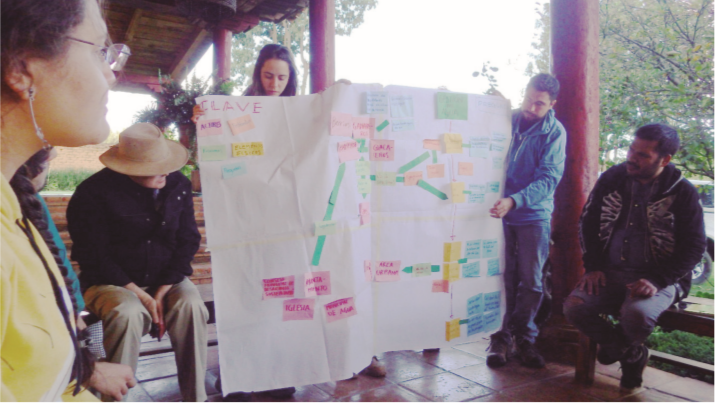
Students and faculty discuss a concept map of the socioecological system in Eronga (Credit: Erin C. Pischke)
DAWN R. BAZELYa, ANNETTE DUBREUILb AND LUSHANI NANAYAKKARAc
aDepartment of Biology, York University, Toronto, ON Canada M3J 1P3, dbazely@yorku.ca
bCanada’s Ecofiscal Commission, c/o Department of Economics, McGill University, 855 Sherbrooke Street West, Montreal, QC H3A 2T7
cDepartment of Biology, University of Regina, Regina, SK Canada S4S 0A2
ABSTRACT:
Researchers in the fields of environmental science, conservation biology and sustainability studies recognize the importance of engaging stakeholders. Due to implicit or unconscious bias, it is highly likely that when researchers prepare their lists of people and groups who may be affected by, or interested in, their research, some stakeholders will be omitted. Use of Open Space Technology, part of the Unconference engagement framework, in the early stages of research, can diversify and increase stakeholder participation.
KEYWORDS:
Stakeholder engagement, Open Space Technology, OST, unconference, science policy, invasive species.
RESUMEN:
Investigadores en los campos de ciencias ambientales, biología de conservación, y sostenibilidad reconocen la importancia de involucrar a la comunidad beneficiaria. Debido a un sesgo implícito o inconsciente, es muy probable que cuando los investigadores preparan sus listas de personas y grupos que pueden ser afectados o interesados en su investigación, algunas partes interesadas pueden ser omitidas. El uso de la tecnología de espacio abierto en las primeras etapas de la investigación, dentro del marco de referencia de la desconferencia, puede diversificar y aumentar la participación de las partes interesadas.
PALABRAS CLAVE:
Participación de los interesados, Conferencia de Espacio Abierto, desconferencia, Política científica, especies invasoras.
INTRODUCTION
In the Brothers Grimm fairy tale, The Sleeping Beauty, seven (or 12) fairies are invited to the christening of a baby princess. The first six (or 11) fairies grant the baby gifts, including beauty, and goodness. Just before the seventh (or 12th) fairy gives her gift, an old fairy, that everyone thought was dead, gate-crashes the party. Angry at not having been invited, the forgotten fairy curses the baby princess with death, when she pricks her finger on a spinning wheel spindle. The seventh (or 12th) fairy cannot entirely reverse the curse. But she can transform it, saying that when the princess pricks her finger, she will not die. Instead, she will fall into a deep sleep, from which she can only be wakened by the kiss of a prince.
Imagine, for a moment, what would have happened if the baby’s parents had known about the importance of stakeholder engagement, and known that there might be gaps in their invitation list? If the king and queen had invited everyone to the christening, perhaps the forgotten fairy would not have been so upset, and we would not have this fairy tale, and the Disney movie!
This technical note has three objectives:
1. To illustrate how engaging stakeholders in environmental management
research can give insights that scientists would not, otherwise, gain.
2. To connect the goal of stakeholder engagement with equity, diversity
and inclusivity (EDI) policy and research.
3. To describe how the Unconference (Budd et al., 2017), including
Open Space Technology (Owen, 2008) can increase stakeholder
inclusivity and participation.
Researchers want to engage stakeholders
A search of the Web of Science database for articles containing the phrase “stakeholder engagement” returned one article in 2000, 65 articles in 2010, and 322 articles in 2016. A similar search in SCOPUS returned 2 articles in 2000, 118 in 2010, and 462 in 2017.
Today, environmental scientists readily acknowledge that efforts to safeguard vulnerable habitats from a multitude of threats, must include the human dimension. Large-scale conservation efforts require the support of diverse public groups, including members of local communities, in order to successfully meet their objectives (Christie et al., 2017).
Knowledge about stakeholder perceptions of conservation, environmental and sustainability projects, and their social impacts, is key for researchers seeking local support for their plans (Bennett, 2016). Conversely, a lack of stakeholder engagement can result in critical knowledge gaps between scientists and non-scientists, leading to failures in policy, planning, and project implementation (Nanayakkara & Wissel, 2017).
How a stakeholder survey shaped a science-policy narrative
A study of prairie lakes in southern Saskatchewan, Canada, explicitly incorporated both human dimensions, and lake ecosystem dynamics (Nanayakkara & Wissel, 2017; Nanayakkara et al., 2017). A stakeholder survey assessed perceptions of lake use, climate change, invasive species, water quality (eutrophication), water extractions, and lake management. Themes emerging from this survey included sport fish and invasive species, which in turn, helped in organizing ecosystem data from limnological surveys. Data collected on the physical, chemical, and biological parameters of lakes, informed by the stakeholder survey, enabled the authors to study watershed dynamics directly related to the survey’s emerging themes.
This interdisciplinary approach provided a more holistic picture of these heavily used prairie lakes, by giving insights into under-studied stakeholder perceptions. For example, some stakeholders were unaware that nonindigenous zebra and quagga mussels were not present in Saskatchewan. Because the lake-users surveyed thought that these invasive species were already present, they were less likely to clean their boats, leading to an increased likelihood of ‘accidental’ introductions of these mussels to uninvaded lakes.
Understanding stakeholder perceptions, and critical knowledge gaps, helped to identify more effective, cohesive narratives for scientific knowledge transfer and science communication. Stakeholders were primarily concerned about sport-fish, so the discussion of invasive species addressed how zebra mussels and other non-native species specifically impact these valuable species (Nanayakkara et al., 2017; Nanayakkara & Wissel, 2017).
Engagement as an equity, diversity and inclusivity issue
Finding ways of successfully incorporating human dimensions into largescale biological conservation planning cannot be an afterthought. While local stakeholders are an integral part of the conservation equation, they are often left out of critical aspects of decision-making (Bennett, 2016).
Strategies for increasing stakeholder engagement include interdisciplinary collaborations, clear written and verbal communication, actionable advice, and identifying a salient narrative that frames scientific findings in a context that makes their policy-relevance clearer (Burgman, 2015; Leslie et al., 2013; Rose, 2015; Rose et al., 2016). However, these strategies all assume that researchers have identified and contacted all possible stakeholders. How do researchers know that this is the case? What if they have failed to identify a potentially disgruntled, forgotten fairy?
We all have implicit or unconscious biases (Project Implicit, 2011). Therefore, it is vital that researchers planning to include a stakeholder engagement dimension in their project, acknowledge this, and take conscious steps to discover and include unexpected stakeholders.
In the for-profit business sector, companies with strong equity, diversity and inclusion (EDI) policies perform better than those without them (Hunt, Layton & Prince, 2015). Various techniques for increasing both EDI and stakeholder engagement have developed in the fields of organizational behaviour, and corporate social responsibility (Jeffery, 2009; Riordan, 2014).
Open Space Technology and unconferences at York University
The Unconference (Budd et al., 2017) approach aims to make stakeholder engagement more diverse and inclusive. Unconferences are participantdriven meetings. While the Unconference is a general category that includes many different “emergent change” practices, for many people, the Open Space Technology (OST) (Owen, 2008) meeting format has become synonymous with the Unconference. Emergence describes a “higher-order complexity arising out of chaos in which novel, coherent structures coalesce through interactions among the diverse entities of a system” (Holman, 2010).
In the Open Space Technology meeting format, participants co-create the agenda at the beginning of the meeting. The agency of participants is fostered by emphasizing that everyone who shows up is meant to be there. OST (Owen, 2008) operates by four guiding principles, and the Law of Two Feet:
1. “Whoever comes is the right people.
2. Whatever happens is the only thing that could have.
3. Whenever it starts is the right time.
4. When it is over, it is over.”
The Law of Two Feet emphasizes that each participant should do what feels right for them during the meeting. If they are not learning or engaged in a session, they should leave, or feel free to sit out for a while. If a topic that the participant would like to discuss is not on the agenda, it is up to them to suggest it be added, and to take the lead in facilitating that small group. Regardless of the chosen emergent facilitation technique, it is essential to create safe spaces that allow participants to share their views in an authentic manner. Two brief videos by Collaborativeways1 (2013) and Camp Stomping Ground (2015) describe the Open Space Technology meeting format.
At IRIS, York University’s Institute for Research and Innovation in Sustainability (2004-2015: http://iris.info.yorku.ca/projects/campus-
IncreaseStakeholderEngagement), we used the OST approach to shape campus sustainability work in climate justice, food security and water security in 2012-13. Results were used to develop future directions arising from campus sustainability surveys (IRISyorku, 2013; SCLD, 2013). These one-day events were advertised to all members of the campus community. Participants set the agenda in the morning, followed by three concurrent breakout sessions. The days closed with conclusions, and a summary.
The benefit, of using the OST method for facilitating stakeholder engagement, was that it did not presuppose which aspects of a problem would be of interest to the group, or who would attend. There is an implicit understanding that everyone has a unique understanding, and perspective, to bring to the problem, as well as a piece of the solution. By hearing these multiple, sometimes, contradictory views, a clearer picture can emerge, followed by the development of novel solutions.
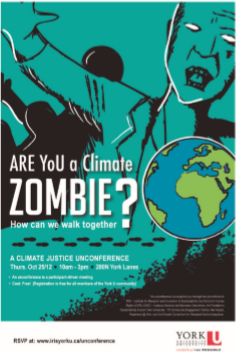
Figure 1. Poster from York University, Toronto’s Institute for Research and Innovation in Sustainability, advertising a unconference about climate change and climate justice in 2012: “Are you a climate zombie? How can we walk together?”
CONCLUSIONS
When done early in research projects, stakeholder engagement activities, including stakeholder surveys, can identify knowledge gaps and policyrelevant narratives.
The use of inclusive, non-judgmental Unconference formats, can increase and diversify stakeholder participation. The Open Space Technology type of Unconference that we described, provides a welcoming environment in which every participant feels valued. Ultimately, gaining the input and participation of less obvious stakeholders provides a more holistic picture of the system of interest.
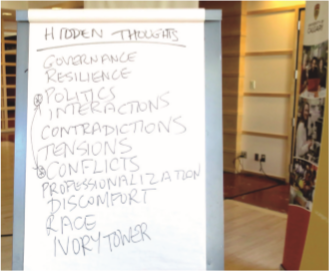
Figure 2. At the Professional Development Seminar on Transdisciplinary Approaches to Integrating Policy and Science for Sustainability workshop in October 2017, Dawn Bazely held a mini-uniconference during her presentation. This is a list of topics that participants said that they would like to discuss more during the meeting.
REFERENCES
Bennett, NJ. (2016) Using perceptions as evidence to improve conservation
and environmental management. Conservation Biology, 30: 582–592.
Budd, A. et al. (2017) Ten Simple Rules for Organizing an Unconference.
PLOS Computational Biology. https://doi.org/10.1371/journal.
pcbi.1003905
Burgman, M. (2015) Governance for Effective Policy-Relevant Scientific
Research: The Shared Governance Model. Asia and the Pacific Policy
Studies, 2: 441–451.
Camp Stomping Ground. (2015) “Open Space Technology Introduction”
Youtube video 1m45s, May 19, 2015. Accessed January 15, 2018.
https://youtu.be/M_jhcvCYBbg
Collaborativeways1. (2013) “Online Open Space Technology Meetings”
Youtube video 9m16s, Feb 28, 2013. Accessed January 15, 2018.
https://www.youtube.com/watch?v=QhNQ8Mhehpw.
Christie, P, et al. (2017) Why people matter in ocean governance: Incorporating
human dimensions into large-scale marine protected areas. Marine
Policy. 84: 273-284.
Holman, P. (2010) Engaging Emergence: Turning Upheaval into Opportunity.
Berrett-Koehler Publishers, San Francisco, California.
Hunt, V., Layton, D. and Prince, S. (2015) Diversity Matters. McKinsey and
Company. https://www.mckinsey.com/business-functions/organization/
our-insights/why-diversity-matters Accessed December 11, 2017.
IRIS-York University (irisyorku). (2013) “The agenda for the Food Unconference
is waiting for you to set the agenda! #yorku https://twitter.com/irisyorku/
status/308599438769803264” 10:26 AM EST - 4 Mar 2013.
Jeffery, N. (2009) Stakeholder Engagement: A Road Map to Meaningful
Engagement. The Doughty Centre for Corporate Responsibility, Cranfield
School of Management, Bedfordshire, UK. https://dspace.lib.cranfield.
ac.uk/handle/1826/3801
Leslie, H, et al. (2013) How Good Science and Stories Can Go Hand-In-
Hand. Conservation Biology, 27: 1126–1129.
Nanayakkara, L, & Wissel, B. (2017) Preliminary investigation of lakeuse
patterns in prairie lakes, stakeholder perceptions, and resulting
management implications. Lake and Reservoir Management, 33(1): 49-
61.
Nanayakkara, L, et al. (2017) In lakes but not in minds: stakeholder knowledge
of invasive species in prairie lakes. Biological Invasions. https://doi.
org/10.1007/s10530-017-1564-4
Owen, H. (2008) Open Space Technology: A User’s Guide, 3rd Edition.
Berrett-Koehler Publishers, San Francisco, California.
Project Implicit. (2011) Project Implicit at https://implicit.harvard.edu/implicit/
aboutus.html
Riordan, CM. (2014) Diversity Is Useless Without Inclusivity. Harvard Business
Review https://hbr.org/2014/06/diversity-is-useless-without-inclusivity
Accessed December 11, 2017
Rose, DC. (2015) The case for policy-relevant conservation science.
Conservation Biology, 29: 748–754.
Rose, DC, et al. (2016) Honest advocacy for nature: presenting a persuasive
narrative for conservation. Biodiversity and Conservation.
SCLD (YorkUscld). (2013) RT @irisyorku: The Food Unconference agenda to
date! Come join a discussion and grab some lunch top! #yorku https://
twitter.com/yorkuscld/status/308619680208281600” 11:47 AM EST -
4 Mar 2013
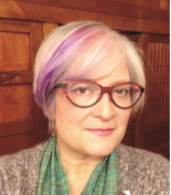
AUTHOR BIOGRAPHY:
Dawn R. Bazely is a University Professor in Biology, York University, Canada. Former director of the Institute for Research and Innovation in Sustainability (IRIS). Her research focuses on the science-policy-politics nexus. She advocates for citizen science, and for scientists to be better public science communicators.
NAOMI KROGMANa, GARY MACHLISb
aDepartment of Resource Economics and Environmental Sociology, University of Alberta, Edmonton, AB, Canada
nkrogman@ualberta.ca
bUniversity Professor of Environmental Sustainability, Clemson University, Central, South Carolina, USA
machlis@clemson.edu
ABSTRACT:
This paper reports on the results of a workshop in Haiti and Puerto Rico to capture what priorities may be important to build sustainability sciences and education. In 2015, approximately 35 individuals attended all or part of the workshop at each location. Participants included academic leaders, university faculty, secondary school teachers, representatives of non-profit organizations, and university and high school students. Haitian participants called attention to the need for reforestation training, systemic solutions for waste management, and sustainable marine resources management. In Puerto Rico, participants called for more training to link civic engagement with sustainable development, social determinants of health, and programming on tsunami preparation and recovery. Members of both workshops asked for sustainability science and education advances in renewable and alternative energy development, general disaster and climate change impact preparedness (e.g. drought), and sustainable agriculture. Haitian and Puerto Rican participants also shared the view that engaging sustainability requires higher educational institutions to partner with communities, primary and secondary school teachers, policy-makers, and especially young persons, to reinforce the values of sustainability, and collectively work across sectors to learn through trial and error together.
KEYWORDS: Sustainability sciences, education, Haiti, Puerto Rico, transdisciplinarity
RESUMEN:
El presente artículo reporta los resultados de un taller en Haití y Puerto Rico el cual identifica qué prioridades pueden ser importantes para construir ciencias de la sostenibilidad y educación. En 2015, aproximadamente 35 personas asistieron a todos o parte del taller en cada ubicación. Los participantes incluyeron académicos, líderes, profesores universitarios, profesores de secundaria, representantes de organizaciones sin fines de lucro, y estudiantes universitarios y de secundaria. Los participantes haitianos llamaron la atención sobre la necesidad de formación en reforestación, soluciones sistémicas para la gestión de residuos y gestión sostenible de recursos marinos. En Puerto Rico, los participantes pidieron más capacitación para vincular el compromiso cívico con el desarrollo sostenible, determinantes sociales de la salud y programación sobre preparación para tsunamis y recuperación. Los miembros de ambos talleres pidieron ciencia para la sostenibilidad y avances de educación en energías renovables y desarrollo de energía alternativa, preparación para desastres naturales e impacto del cambio climático (por ejemplo, sequía) y
agricultura sostenible. Los participantes haitianos y portorriqueños también compartieron su visión de que comprometer la sostenibilidad requiere que las instituciones de educación superior se asocien con las comunidades, maestros de escuelas primaria y secundarias, formuladores de políticas, y especialmente jóvenes, para reforzar los valores de la sostenibilidad, y trabajar colectivamente en todos los sectores para aprender juntos a través de prueba y error.
PALABRAS CLAVE: Ciencias de la sostenibilidad, educación, Haití, Puerto Rico, transdisciplinaridad
INTRODUCTION
The question of how to teach sustainability is important across the world as educational institutions continue to recognize the contextsensitive and site-specific approaches needed to address climate change, biodiversity loss, desertification, sustainable livelihoods, and the historical and continuing relationships among health, food and energy security, social justice and the renewability of ecosystems. Higher education institutions can help promote sustainability as a core strategy for progress, and offer courses and programs to teach transdisciplinary approaches to integrate policy and science into sustainability. This paper reports on two workshops with stakeholders in Haiti and Puerto Rico held in 2015 to address: 1. What should be the goals of the sustainability sciences?; 2. What should be the goals of sustainability education?; and 3. What are the strategies and tactics to achieve these goals? This paper summarizes the responses in the workshops to these questions, and offers a few specific recommendations regarding advancing sustainability science and education in Haiti and Puerto Rico, and several broader suggestions about how the process carried out in Haiti and Puerto Rico could be integrated into sustainability planning across the Americas.
The sustainability sciences include the biophysical, socio-cultural, and interdisciplinary sciences, and sustainability education includes both formal and informal learning at the higher education level, as well as experiential and service learning related to sustainability. There are currently many universities with interdisciplinary sustainability academic programs at the undergraduate and graduate level such as the University of Alberta (Canada), Arizona State University (United States), and Stockholm University (Sweden).
The emergence of sustainability as a subject of university education and research is not new. The United Nations has called on higher education institutions to address environmental and development issues for many years, and designated the years 2005-2014 as the Decade of Sustainable Development (Sterling 2010). More recently, the United Nations has urged educational institutions and all sectors of society to address 17 Sustainable Development Goals (SDGs), with support from 193 world leaders (UNESCO 2017). Scholars have described a wide range of approaches to teaching sustainability in higher educational institutions (Sipos et al 2008; Tilbury, 2011, Wals, 2009; Wright 2013).
While higher education institutions around the world are engaged in sustainability initiatives, there is a significant lack of guidance on how such institutions can effectively plan for and implement these initiatives in ways that are distinctive to national cultures and higher education institutions, affordable within financial constraints, and forward looking (Clark et al 2011). In Haiti, the role of universities as solution providers for sustainable development has been mostly ignored by the public and private sectors, as well as international stakeholders. In Puerto Rico, higher education is far more accessible to the population, although government austerity measures leave higher educational institutions significantly underfunded.
The Haiti and Puerto Rico workshops were part of a larger Sustainability Sciences and Education Project sponsored by the American Association for the Advancement of Science (AAAS), Clemson University, the University of Alberta, the recently formed Haitian Association for the Advancement of Science and Technology (HAAST) and the Caribbean Division of the AAAS. These workshops had three main objectives: 1) provide stakeholder-driven guidance on future directions of sustainability initiatives at Haitian and Puerto Rican higher education institutions, 2) foster communication and collaboration amongst institutions with similar sustainability goals within Haiti and Puerto Rico, and 3) help build capacity for sustainability leadership in Haiti and Puerto Rico.
Background on host countries and workshops
Haiti, as it has so often been in its history, is at a crossroads. Rebuilding from the devastating 2010 earthquake, the people and institutions of Haiti are working to find new strategies for economic and social development, new solutions for old problems such as inadequate infrastructure, and new opportunities for creating a sustainable and prosperous Haiti. Puerto Rico also faces an uncertain economic and environmental future, especially with its current recovery efforts from Hurricane Maria in September 2017. When the workshop occurred, Puerto Rico was already coping with outmigration trends, inadequate funding of public services (including public higher education), and challenges to the growth of employment opportunities. Climate change, sea-level rise, energy and potable water availability, and continuing risks from hurricanes, also create uncertainties and challenges. Both Haiti and Puerto Rico are now in the midst of long term recovery efforts related to the 2017 Hurricanes Irma and Maria that will even further limit higher education capacity, whilst increasing the importance of sustainability and resilience training.
The workshop in Haiti was conducted on 6 May 2015 at the Hotel Montana, Petion-ville, Haiti, and in Puerto Rico on 12 September 2015 at the University of Puerto Rico in San Juan. The workshop in Puerto Rico was hosted by Caribbean Division of the AAAS during its 2015 Annual Meeting at the University of Puerto Rico Medical Sciences Campus. The theme of the Annual Meeting was “Attaining Sustainability Through Science and Education.” Approximately 35 individuals attended all or part of the workshop at each location. Participants included academic leaders, university faculty, secondary school teachers, representatives of non-profit organizations, university and high school students, and others.
The authors of this paper facilitated the discussions. In Haiti, the workshop was conducted in French and English, with simultaneous translation, and recorded on video, whereas in Puerto Rico, the workshop was conducted in Spanish and English, with simultaneous translation. One facilitator took notes summarizing participants’ comments while the other led a discussion. After introductions and an overview of sustainability science and education at each location, the discussions (each lasting approximately 90 minutes in Haiti, 30 minutes for each question in Puerto Rico) were organized into three sessions linked to three key questions:
1. What should be the goals of the sustainability sciences in Haiti/ Puerto Rico?
2. What should be the goals of sustainability education in Haiti/Puerto Rico?
3. What are the strategies and tactics in Haiti to achieve these goals in Haiti/Puerto Rico?
The workshops concluded with a brief summary of the discussions and a description of next steps. After the workshop was completed, all comments by participants were reviewed and placed with the responses to one or more of the three questions. In some cases, a response made during a particular discussion session was more appropriate to a different question session, and was placed in that session for analysis.
The workshop results have several limitations. First, the time allowed for each question limited the breadth and depth of the discussion. Second, the results are dependent upon the individuals and mix of institutions represented in the workshop; a different set of participants might provide different results. Third, the concepts of sustainability science and sustainability education were relatively new to some participants, limiting their opportunity to provide comment. Given the small percentage of students who enter higher education in Haiti, significant concern and interest was expressed about sustainability education at primary and secondary levels. In Puerto Rico, participants were more focused on sustainability education in post-secondary institutions.
The results represent the guidance of a broad set of stakeholders in higher education and research and can provide useful insights into advancing sustainability science and education within Haiti and Puerto Rico. The links between primary, secondary, and post-secondary education made by our participants illustrated the opportunity to ladder, or build upon previous learning and skill development, in a much more deliberate fashion across the Americas. High school education for a student in Haiti, for example, may call for more hands-on experience in sustainability projects due to the fact fewer students can afford higher education. Participants’ expressed deep appreciation for the opportunity to speak to the experiments and lessons they had learned, in situ, that could inform a more targeted approach to transdisciplinary teaching, research and collaboration in their countries. Across the Americas there may be opportunity
for academic leaders, university faculty, secondary school teachers, representatives of non-profit organizations, university and high school students to share their experiences, ideas, and organizational abilities to enrich sustainability education.
Much of the material in this paper is drawn from two American Association for the Advancement of Science reports in which the authors summarized the workshop results (Krogman and Machlis, 2016; Machlis and Krogman 2016).
Workshop results
Goals of sustainability sciences
1. What should be the goals of the sustainability sciences in Haiti?
There are three general overarching themes that emerged from the participants’ statements at the workshop. First, the sustainability sciences in Haiti should focus on the protection and sustainable use of the fundamental natural resources of the country. Among these are water, land (especially arable and forested land), and marine resources. A suggestion was made to create a national inventory of the land of Haiti that identifies lands that cannot be cultivated due to drought or deforestation, and lands that hold the potential for successful reforestation. Enthusiasm was demonstrated around science that informs farming that is less labor-intensive and more ecologically sustainable, due to the health issues associated with manual farm implements, and the soil erosion and nutrient depletion currently reducing agricultural productivity. Similarly, many participants were interested in sustainability science that could inform incentives and community collaborative approaches that arrest deforestation and improve the longer-term outcomes of reforestation. Interest was also expressed in enhanced marine science that identifies medicinal and edible plant and food harvest possibilities.
A second expressed goal for the sustainability sciences is to create higher education opportunities to directly address Haiti-specific sustainable development. Participants spoke of the unique history, geography, and demographic trends (e.g. majority of population is young or of child bearing age) in Haiti that call for sustainable development initiatives informed by distinct Haitian needs. In particular, participants called for greater science and scholarship in risk management, disaster preparedness, and enhancing resiliency for Haiti. Country-specific research could be conducted on:
• alternative energy development (solar, biogas, waste product energy),
• pollution abatement and waste management, particularly in regards to recycling science and practice (e.g., reuse of plastics, using waste to make other products, potentially involving robotics),
• building termite-resistant homes,
• efficient and affordable transportation for people across Haiti,
• communication technologies that would foster these sustainable development initiatives above, and
• most importantly, identify places of high risk, in terms of potential disaster and climate change impacts, and the ability for communities to prepare, adapt, and make improvements in these high-risk areas.
Participants felt that the sustainable development needs of Haiti should emerge from communities across Haiti, and specifically engage and integrate community members in needs assessments, experimental and demonstration projects, test-applications, and partnerships to implement and evaluate interventions. They also felt the accumulated knowledge should be made public and easily accessible.
Participants felt that a third goal of sustainability science in Haiti should be to create a partnership between higher education, scientific research, and public policy. Essential to this task, some participants held, is the need to re-establish a reliable Haitian Census. Participants expressed concern about the absence of a current and longitudinal analysis of the demographics and conditions of the Haitian population, rendering many development efforts in Haiti poorly informed about their target populations. Participants also suggested the development of research centres to more effectively build collaborations between higher education institutions, and among Haitian researchers and the global academy of scientists who work in Haiti, the government, nongovernmental organizations, the private sector, and communities.
What should be the goals of the sustainability sciences in Puerto Rico?
Among the Puerto Rican participants there was high interest around promoting an interdisciplinary approach to complex problems that affect the future of Puerto Rico. Participants identified key topic areas for the sustainability sciences in Puerto Rico, including:
• sustainable development,
• social determinants of health,
• healthy communities,
• sustainable agriculture, and
• renewable energy.
Participants felt that one of the goals of the sustainability sciences in Puerto Rico should be to train students to understand the data needed to examine complex problems, how to integrate different data sets, apply appropriate statistics, and use the findings of such research to address current challenges. For the sustainability sciences to succeed in Puerto Rico, participants suggested that there needs to be a
government-provided solid base of funding to support sustainability research and to support university laboratories.
Some of the participants held that the high reliance on external funds from the US-based National Science Foundation and the National Institutes of Health inhibits the ability to carry out research on broader sustainability topics such as integral health and sustainable economic development for Puerto Rico. One option offered was a governmentsupported research cooperative to give secure funding to basic research that supports the sustainability sciences.
For several participants, effective sustainability science in Puerto Rico requires student and researcher engagement with community challenges, problem-based learning, and experiments. These applied trial-and-error experiences could help transform Puerto Rican society toward a more sustainable future through more sustainable designs, practices, policies, and civic involvement.
Goals of sustainability education
2. What should be the goals of sustainability education in Haiti?
There were two theme areas for responses to goals of sustainability education in Haiti. First, educational efforts should be increased in the areas of risk management, disaster-preparedness, and approaches and designs for recovery and resilience. This training was seen as part of education that places content about risks, disasters, and resiliency as pedagogy on systems and systemic thinking about linkages among multiple elements, such as the stages of preparation, disaster event, and recovery over time. Participants suggested interdisciplinary systems training could help explain the interacting factors of shelter, water, farming, food, technology, transportation, and support for governance, human health, communication, education, and employment. Such system-focused curriculums would also address agriculture-environmental connections, climate change, energy,
reforestation, tourism, public policy, governance, and cultural barriers to sustainable development.
Secondly, participants felt that the goal of sustainability education should be to connect higher education institutions to communities as well as international research programs working on similar issues, through the research centres described above and study centres in communities. For example, such study centres could be places for secondary students to participate in learning experiences (e.g., “Reforestation Days”) or a research project initiated by a Haitian university. The study centres could also be a place for community teachers to attend workshops (for example, on the basics of the scientific method or on models for sustainable development) led by a Haitian higher educational institution. Participants suggested the scientific training of teachers in Haiti is weak, and continuing education in this area is needed. They also felt that continuing education of teachers is needed to nurture student curiosity, enthusiasm, and awareness of the role of science in civic well-being, and to better prepare students for careers in science that require higher education.
In general, greater cooperation and exchange between higher educational institutions and communities could potentially foster transdisciplinary, cross-sector, experimental, experiential, and proactive learning. Participants felt that secondary and post-secondary students need this kind of learning to understand the importance and application of knowledge and skills and to contribute to Haiti’s development. Several participants suggested that students and faculty in higher educational institutions can be far more effective if they have direct experience working with communities, in order to learn about in situ priorities (e.g., improving farmer livelihoods) for sustainable development and gain the skills of developing specific solutions for Haitian communities.
Consistent emphasis was placed by participants on the high proportion of Haitian students who will not attend a higher educational institution, and hence the importance of learning opportunities for primary and secondary teachers and their students, and more broadly community members. Participants felt that students need to understand their own potential to combine a variety of skills in the trades, and the related opportunities for entrepreneurship, to help build and improve Haiti’s infrastructure and develop small-scale businesses. Issues addressed in Haiti exist in many other developing countries, and locally developed solutions can and should be exportable and usable elsewhere. Many participants held that entrepreneurial opportunities exist in waste recycling, energy/electricity development, and reforestation.
One participant expressed concern about the barrier of language for students capable of pursuing a higher education but who only speak Creole, given that French is the primary language in which higher education is delivered. Greater creativity in teaching sustainability education in Creole and teaching French in rural areas may be required to effectively reach the broader Haitian population.
What should be the goals of sustainability education in Puerto Rico?
Participants at the workshop called for a set of “holistic education” programs that provide investigation opportunities linked to action. According to some participants, the key question to be addressed in sustainability education, is “How can science be integrated into action?”
Some participants held that science and its application must be demonstrated in communities and engage community members, e.g. through a range of activities, including (for example):
• trials in sustainable farming,
• community gardening,
• models for greater civic engagement,
• converting empty spaces in Puerto Rico to other fruitful uses,
• building and installing solar cells and transformers in communities,
• and tsunami preparation.
Enthusiasm was expressed around the way informal teaching methods in the community and applied science can increase public interest in science and basic science understanding in fundamental ways. For example, one professor shared his experience of teaching chemistry to 700 students by tying concepts of polymers, physics and lights to waste management and recycling.
Civic engagement was seen as an especially important part of sustainability education because of the importance of self-reliance and in-country leadership, given Puerto Rico’s distinctive history of colonialism and challenges to self-organization around collective problems. Thus, critical thinking pedagogy is also an important part of sustainability education in Puerto Rico.
Strategies and tactics to achieve sustainability sciences and
education goals
3. What are the strategies and tactics in Haiti to achieve these
goals?
Several themes emerged from the discussion of strategy and tactics in Haiti. Many participants (including the student representatives) reported that developing significant opportunities for life-long learning was the foundation for long-term sustainability in Haiti. Participants stated that sustainability can and should be integrated into the curriculum early, “even in primary school” and definitely in
secondary and higher education. Importantly, the values of empathy, solidarity, and collaboration were seen as essential elements to impart on young persons, to help create motivation and interest in subjects (from science to civics) relevant to Haitian sustainability. Building student interest, skill, and confidence in solving local problems had strong support amongst participants. Teaching “how to learn” and training students “to keep them learning” were seen as important strategies.
In addition to this expanded view of sustainability education, there were several institutional strategies proposed. One was to ensure that the “systems perspective” is part of the curriculum, so that students can better understand the key linkages between environment, economy, society, and culture. This necessarily requires interdisciplinary coursework and teachers skilled in systems thinking. While participants felt that the systems perspective could and should be integrated into sustainability education and research at all levels, there was specific interest in developing a sustainability certificate for higher education students, modeled after the certificate program at the University of Alberta.
A third theme was the importance of higher education investing in applied research at the local level, to help Haitians solve problems and advance sustainability. Participants recommended that university students, even at the beginning of their training, could and should be engaged in problem-solving research. Further, advanced students (particularly for PhD students) should conduct research that is relevant to Haitian needs, applied to Haitian problems, and communicated to Haitian decision makers. Reducing current course loads to create opportunities for hands-on research was seen as an important strategy.
For faculty, this emphasis on systems-level science and applied research suggested several important strategies and tactics. With the
heavy teaching loads carried by Haitian faculty, creating opportunities for student and faculty research may benefit from informal collaboration. Participants also asserted that they would benefit from formal partnerships focused on sustainability science with universities outside Haiti, external scientists and international students.
What are the strategies and tactics in Puerto Rico to achieve these goals?
Participants had widely varied views on strategies and tactics to achieve sustainability science and education goals for Puerto Rico. Some were optimistic in advancing sustainability in Puerto Rico; others were pessimistic about the possibility for change. One area of agreement was that a significant values shift was required, and that values associated with environmental care and sustainable practices needed to be imparted throughout Puerto Rican society. Recent drought and climate change offered opportunities to link a shift in values to Puerto Rico’s future. (We suspect this shift in values toward sustainability is even stronger as Puerto Rico rebuilds its energy and potable water systems after Hurricane Maria.) Participants asserted that education—both formal for young persons and informal for adults—needed to include valuing nature, and that tactics such as social media campaigns and demonstration projects (such as community gardens) should be part of this effort.
A second key theme was that strategies should include formal collaborative agreements with other Caribbean countries (including Cuba) that would encourage:
• community education in sustainability and sustainable practices,
• formal school and university sustainability curriculums (including courses, certificates, and degrees as appropriate),
• exchange programs in sustainability, focused on faculty, students, and community groups,
• national, regional, and local meetings to share best practices in sustainability, with broad use of social media to disseminate ideas and practices, and
• funding for sustainability initiatives, including support from world organizations and matching funds from other countries.
Participants also cautioned that action is important, and that resistance to change must be overcome if sustainability is to become integral to Puerto Rico’s future.
DISCUSSION
The different goals and strategies voiced at the workshops on Haiti and Puerto Rico illustrate the need for country-specific sustainability science and education development. Participants called for support for research in the specific sustainability challenges for their people and land. For example, Haitian participants called attention to the need for reforestation training, systemic solutions for waste management, and sustainable marine resources management. In Puerto Rico, participants called for more training to link civic engagement with sustainable development, social determinants of health, and programming on tsunami preparation and recovery. Members of both workshops identified as important sustainability science and education advances in renewable and alternative energy development, general disaster and climate change impact preparedness (e.g., drought), and sustainable agriculture. Haitian and Puerto Rican participants also shared the view that engaging sustainability requires higher educational institutions to partner with communities, primary and secondary school teachers, policy-makers, and especially young persons, to reinforce the values of sustainability, and collectively working across sectors to learn through trial and error together.
This research corroborates a recent Organization of the America’s publication (OAS, nd) on Environmental Sustainability in the Americas. In that policy brief, the authors hold that the key sustainability issues common across the Americas include: 1) issues of access to technology and know-how, and access to natural resources, especially for the poor; 2) ensuring the sustainability of water resources; 3) mitigating natural hazard risk; 3) reducing land degradation; and 4) reducing economic, social and environmental vulnerability. Using these topics in workshops to then generate country-specific content for transdisciplinary curriculums and programs may be a useful approach across the Americas.
CONCLUSIONS AND RECOMMENDATIONS
The project directors (who served as facilitators for the workshops) reviewed the workshop comments and from the above discussion, developed several general recommendations for higher education institutions in Haiti and Puerto Rico.
Haiti
1. Haitian sustainability policy and practice can be informed by policies and practices in other countries (such as the US, Canada, and developing countries confronting similar problems) but should be distinctively Haitian and derived from local community engagement.
2. Sustainability science in Haiti should be fully integrated into sustainability education; i.e., learning about sustainability should include research experiences at all levels of Haitian education.
3. Sustainability sciences and education in Haiti should include applied biophysical science, socioeconomic science, and interdisciplinary science, and focus on systems-level understanding and the protection and sustainable use of Haitian natural resources.
4. Haitian higher education institutions should consider partnering with universities outside Haiti to develop a primary-secondary-undergraduate curriculum proposal to promote sustainability education in Haiti.
5. In collaboration with select universities in the US and Canada, a certificate program in sustainability should be developed appropriate to Haiti, including distance learning where most effective.
Puerto Rico
1. Puerto Rican universities should empower their faculty, staff, and students to advance sustainability policies and practices both within the institutions as well as in broader Puerto Rican society. This includes both sustainability research (including studies of environmental values within Puerto Rico society) and education both within the curriculum and through outreach to Puerto Rico’s citizens.
2. The integration of sustainability into youth education (including environmental values and sustainable practices) should be made a national and institutional priority, and student learning can be leveraged to engage adults and broader Puerto Rican society.
Across the Americas, there is a great need for partnership in sustainability research to offset the inequities and variabilities in research capacities of institutions, and to enrich transboundary, cross-cultural learning about diverse approaches to address sustainability challenges. A common theme among the voices in our study, and likely applicable elsewhere, is the need for sustainability thought and practice to be mainstreamed across the primary, secondary and post-secondary curriculum, where social, natural and physical sciences are all applied to in-country sustainability challenges.
Puerto Rico and Haiti represent just two distinct cultures and educational systems, but the approach described here has potential elsewhere. As sustainable development and sustainable economies
environments, and cultures become critical benchmarks of human progress, the role of higher education institutions around the world in researching and teaching sustainability must increase in visibility and effectiveness. In doing so, thoughtful consideration of the views of stakeholders—including both educators and students as well as citizens and institutional leaders—can help guide how universities can become agents of change.
ACKNOWLEDGEMENTS
The project directors would like to especially thank the workshop participants. We also express gratitude to the several individuals and institutions that helped make the project and this workshop possible. Dr. Shirley Malcom of the AAAS provided support (both technical and financial) from the AAAS to make the project possible. In the US, assistance was provided by Alexis Ward and Maddie Duda; in Canada assistance was provided by Apryl Bergstrom. In Haiti, the project benefited from the support of the HAAST leadership, including Patrick Attie, Fritz Deshommes, Guy Etienne, and Dr. Evens Emmanuel. Beatrice Talon provided her exceptional organizing skills.
REFERENCES
Clarke, Susan. G., Murray B. Rutherford, Matthew R. Auer, David N.,
Cherney, Richard L. Wallace, David J. Mattson, Douglas A. Clark,
Lee Foote, Naomi Krogman, Peter Wilshusen, Toddi Steelman.
2011. “College and University Environmental Programs as a Policy
Problem (Part 1): Integrating Knowledge, Education, and Action
for a Better World? Environmental Management. DOI: 10.1007/
s00267-011-9619-2.
Executive Secretariat for Integral Development, nd. Environmental
Sustainability in the Americas. Accessed January 6, 2018.https://www.
oas.org/dsd/publications/Documents/EnvironmentalSustainability_
ENG.pdf
Krogman, Naomi and Gary Machlis. 2016 Sustainability Science and
Education in Haiti: A workshop report the American Association
for the Advancement of Science and the Caribbean Division of the
American Association for the Advancement of Science.
Machlis, Gary, and Naomi Krogman. 2016 Sustainability Science and
Education in Haiti: A workshop report the American Association for
the Advancement of Science and The Haitian Association for the
Advancement of Science and Technology.
Sipos, Yona, Bryce Battisti, and Kurt Grimm. 2008. “Achieving
Transformative Sustainability Learning: Engaging Heads, Hands and
Heart.” International Journal of Sustainability in Higher Education
9(1):68-86.
Sterling, Stephen. 2010. “Learning for Resilience, or the Resilient
Learner? Towards a Necessary Reconciliation in a Paradigm of
Sustainable Education.” Environmental Education Research 16(5-
6):511-528.
Tilbury, Daniella. 2011. Education for Sustainable Development: An
Expert Review on Processes and Learning for ESD. Paris: UNESCO.
Accessed February 25, 2017. http://unesdoc.unesco.org/
images/0019/001914/191442e.pdf
Wals, Arjen E.J. 2009. Learning for a Sustainable World: Review of
Contexts and Structures for Education for Sustainable Development.
Paris: UNESCO. Accessed February 24, 2017. http://www.unesco.
org/education/justpublished_desd2009.pdf
Wright, Tarah. 2013. “Stepping Up to the Sustainability Challenge.” Pp.
201-213 in Higher Education for Sustainability: Cases, Challenges
and Opportunities Across the Curriculum, edited by L.F. Johnson.
New York: Routledge.
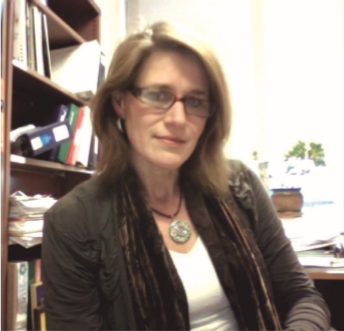 AUTHOR BIOGRAPHIES:
AUTHOR BIOGRAPHIES:
Naomi Krogman is a Professor
of Environmental Sociology in the
Department of Resource Economics and
Environmental Sociology at the University
of Alberta. She has been at the University
of Alberta for almost 20 years. For the
last six years, Naomi has served as
Director of Sustainability Scholarship and
Education out of the Provost’s Office, and
then as an Associate Dean of the Faculty
of Graduate Studies. Naomi’s research
has been on sustainable consumption,
wetland policy implementation, the
challenges of oil and gas, forestry,
farming and conservation activities to co-exist, alternative institutions for resource
management and food production, and social impacts of various land uses. She has
been involved research in India, Mongolia, Zimbabwe, Uganda, Lesotho, El Salvador,
Haiti and Sri Lanka. Her current work focuses on approaches to sustainability in
higher education, and sustainability for the oft-forgotten, including the book with Gary
Machlis, entitled Desolation Row: Sustainability for the Forgotten.
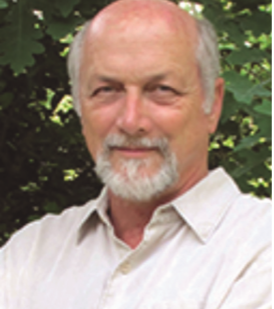 Gary Machlis is University Professor of
Environmental Sustainability at Clemson University.
From 2008-2017 he served in the Obama
administration as the first scientist appointed as
science advisor to the director of the National
Park Service. His research interests include
conservation, urban ecology, humanitarian
response to environmental crises, the politics
of science, and the future of sustainability. His
recent work includes the co-authored books The
Structure and Dynamics of Human Ecosystems:
A Model for Thought and Action (Yale University
Press, 2017), and The Future of Conservation in
America: A Chart for Rough Water (University of
Chicago Press, 2018). Dr. Machlis has worked internationally on a variety of projects,
from giant panda conservation in China to rebuilding scientific capacity in Haiti after
its devastating earthquake. Along with Naomi Krogman, he is at work on a book about
sustainability, entitled Desolation Row: Sustainability for the Forgotten. In 2010 he was
elected a Fellow of the American Association for the Advancement of Science.
Gary Machlis is University Professor of
Environmental Sustainability at Clemson University.
From 2008-2017 he served in the Obama
administration as the first scientist appointed as
science advisor to the director of the National
Park Service. His research interests include
conservation, urban ecology, humanitarian
response to environmental crises, the politics
of science, and the future of sustainability. His
recent work includes the co-authored books The
Structure and Dynamics of Human Ecosystems:
A Model for Thought and Action (Yale University
Press, 2017), and The Future of Conservation in
America: A Chart for Rough Water (University of
Chicago Press, 2018). Dr. Machlis has worked internationally on a variety of projects,
from giant panda conservation in China to rebuilding scientific capacity in Haiti after
its devastating earthquake. Along with Naomi Krogman, he is at work on a book about
sustainability, entitled Desolation Row: Sustainability for the Forgotten. In 2010 he was
elected a Fellow of the American Association for the Advancement of Science.
ABOUT THE JOURNAL
“Vínculos - ESPE” is a peer-reviewed journal published 3 times a year by Universidad de las Fuerzas Armadas – ESPE. It is committed to advance theory and practice related to all forms of outreach and engagement between higher education institutions and communities. This includes, but it is not exclusive, reporting on studies of impact in the areas of public service, outreach, engagement, extension, community-based participatory research, service-learning, critically examining emerging issues, trends, challenges .This special issue is dedicated to the work done by the Inter-American Institute for Global Change Research fostering dialogue and synergies between different disciplinary and cultural perspectives on global change research. Vínculos invites the participants of the “Professional Development Seminar on Transdisciplinary Approaches to Integrating Policy and Science for Sustainability” workshop to look back at the work that has been done, sums up where we are now, and offers glimpses into the future. Thought-provoking essays, story of catalyst of change related to TD teamwork and processes, TD proposal development and project management, TD methods, science-policy interface, TD and Science
diplomacy, science communication, or any other field driving progress. Diverse contributions from all backgrounds are welcome!
TYPES OF CONTRIBUTIONS
Essays - Perspective, opinion, and commentary that present a reflection on the impact of the experience in the personal and professional life. For instance, how this experience helped to shape your personal point of view critiquing widespread notions pertaining to a field. It is recommended not to exceed 10,000 characters (with spaces)
Technical Note - Notes are short papers that present significant new observations and methodological advances. Notes may contain results that are not sufficiently elaborated or developed as to justify an article, but are still of considerable potential significance. It is recommended not to exceed 10,000 characters (with spaces)
Research Article - Detailed studies reporting original research and are classified as primary literature. They include title, abstract, introduction, methods, results, discussion/conclusion,
acknowledgements, and references. It is recommended not to exceed 20,000 characters (with spaces).
Review - synthetic overview of a subfield. These papers are expected to include discussion of new directions, new syntheses, and resolutions of old questions. It is recommended not to exceed 20,000 characters (with spaces).
Press release.- Short science news articles to communicate important information to decision-makers, practitioners, and public in general. It increases awareness of science in the public domain and a broad appreciation of scientific progress, increases awareness of specific scientific projects, instruments or organization missions. It is recommended not to exceed 600 characters (with spaces).
PREPARING YOUR PAPER
Style Guidelines
Papers must be written in American English and should follow the
style guidelines described in the Publication Manual of the American
Psychological Association (6th ed.). Merriam-Webster’s Collegiate
Dictionary (11th ed.) should be consulted for spelling.
Formatting and Templates
Papers may be submitted in Word. Figures should be saved separately
from the text. The main document should be single-spaced, with
one-inch margins on all sides, and all pages should be numbered
consecutively. Text should appear in 12-point Times New Roman.
Checklist: What to include
1. Author Details. Please include all authors’ full names, affiliations,
postal addresses, and email addresses on the cover page. Where
appropriate, please also include social media handles (Facebook,
Twitter or LinkedIn). One author will need to be identified as the corresponding author, with their email address normally displayed in the published article.
2. Abstract. This summary of your article is normally no longer than 200 words.
3. Keywords. Keywords are the terms that are most important to the article and should be terms readers may use to search. Authors should provide 5 to 7 keywords.
4. Body of Manuscript. Please follow the type of contribution description.
5. Supplemental Material. High quality photos (600 dpi for black & white art and 300 dpi for color) are encouraged to be submitted as supplemental material. This material will be used as illustration in the production of the journal. The photos will inspire and engage the reader.
6. Figures. Figures should be high quality (600 dpi for black & white art and 300 dpi for color). Figures should be saved as TIFF, PostScript or EPS files. Figures embedded in your text may not be able to be used in final production. Include a title or caption for each figure (please follow APA formatting). You clarify if the figure/illustration is a reproduction of a previously published image and include an acknowledgement to this effect.
7. Tables. Please supply editable table files. We recommend including simple tables at the end of your manuscript, or submitting a separate file with tables. Tables should have descriptive titles, consecutive numbers, and headings for all columns; do not use vertical lines in the body of the table.
8. Equations. If you are submitting your manuscript as a Word document, please ensure that equations are editable.
Author Agreement/Use of Third-Party Material
Authors are responsible for obtaining permission to reproduce
copyrighted material from other sources. As an author, you are
required to secure permission if you want to reproduce any figure, table
or extract text from any other source. This applies to direct reproduction
as well as “derivative reproduction” (for which you have created a new
figure or table which derives substantially from a copyrighted source).
Submitting Your Paper
Please read the guidelines above and then submits your paper to
vinculos@espe.edu.ec, until December 1, 2017.
Our publication policies
Our detailed publication policies can be found in the Editorial and Publishing policies file [http://journal.espe.edu.ec/index.php/vinculos]. Our compiled policies
cover various topics like conflict of interest, authorship, copyright and license policies. A summary of the main policies are below.
We will follow recommendations by the Committee on Publication Ethics (COPE) https://publicationethics.org/
All articles are subject to peer review before they can be accepted for publication. The acceptance criteria for all papers are the quality and originality of the research and its significance to journal readership.
All articles published by “Vinculos-ESPE”are made freely and permanently accessible online immediately upon publication, without subscription charges or registration barriers.
There are no page charges for publishing in “Vinculos-ESPE”.
In case of any questions, please contact the editors Jessica Duchicela at jiduchicela@espe.edu.ec and Mariana Toledo at marianatoledo@dir.iai.int
ABOUT VÍNCULOS ESPE
• Vínculos ESPE is a publication of Universidad de las Fuerzas Armadas ESPE.
• Vínculos - ESPE is a peer-reviewed journal published 3 times a year dedicated to the promotion of the diversity of
interactions between technology, science and society.
• The journal is available online at http://journal.espe.edu.ec/index.php/vinculos. Please visit the site for submission
instructions and latest information.
• If you have any questions, do get in touch with the central office at vinculos@espe.edu.ec